The birth, flourishing and death of the telegraph
A few decades ago, the telegram was a real event. The postman rang the doorbell, announced the message, handed the envelope. But only the head of the family could read the telegram. He was looking for points for several minutes while he was standing with this telegram, then he first silently, and then read the message out loud. The telegram reported death, birth, congratulations on holidays. Today it is easier to do - you can send a text message or a message in social networks. Here are just a paper carrier stored sometimes longer than we now live phones.
Let us remember how it all began, and how the telegraph became one of the best and fastest means of communication.
Telegram to the parents of cosmonaut German Titov. G.S. Titov Museum
The first apparatuses and telegraph lines
Europe
In 1774, the Swiss physicist Georges Louis Lessage assembled one of the first operational models of the electric telegraph. Information was transferred between two rooms of his house, and a separate wire corresponded to each of the 26 letters of the alphabet.
Another inventor, Lomon, used one wire to transmit information. This is an excerpt from an article published in Dublin in 1793: "Paris, October 16, 1787. In the evening I was with Monsieur Lomon, a very witty and resourceful mechanic who improved the cotton spinning machine ... He made a remarkable discovery in electricity. You write two or three words on paper, he takes the sheet into the room and turns on the car. Locked in a cylindrical case, on top of which is an electrometer - a small cork ball, the wire connects to a cylinder and an electrometer in another room, and Lomon’s wife, noticing the corresponding e ball moves, writes down words. It follows that the inventor has formed an alphabet of movements. Since the length of the wire does not affect the effect, correspondence can be carried out at any distance within the city or behind its walls, or for the purpose of more worthy ones. used, this is a wonderful invention. "

The telegraph of Jean Louis Lessage
On February 22, 1804, Francisco Salvá presented at the Academy of Sciences in Barcelona an electric telegraph based on a Volta battery. The system consisted of six small water tanks. Two wires are lowered into the liquid, and depending on the change of their polarity, each tank shows two signals due to the evolution of hydrogen.
More detailed information, including the alphabet for decoding signals, did not reach us.

Francisco Salva's Telegraph
Five years later, a member of the Bavarian Academy of Sciences, Sömmerring, at the direction of King Maximilian, invents the telegraph, again using electrolysis and a volt pole . An aquarium was placed on the receiving side, in which hydrogen bubbles were emitted from the electrode corresponding to the desired letter. Half the number of oxygen bubbles formed from the second letter - that is, two characters were simultaneously walking along the wires.
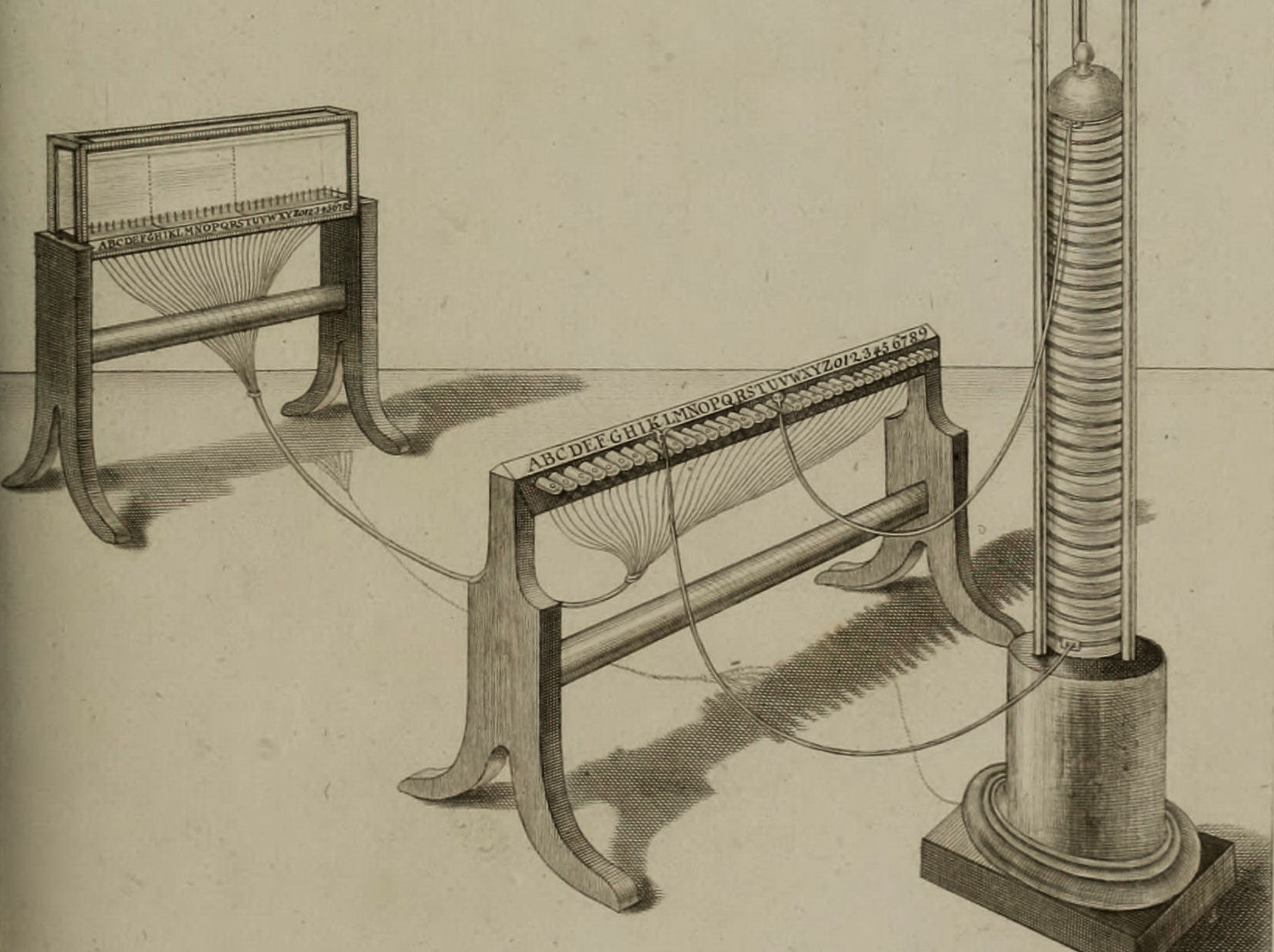
Telemer Telegram
In 1820, Danish physicist Hans Christian Oersted sent a brochure entitled Experiments Concerning the Effect of an Electric Conflict on a Magnetic Pointer to accessible scholarly institutions and journals.
At lectures at the university, he demonstrated the heating of the wire with electricity from a volt column. On the table during the experiment lay a sea compass, over the top of which the wire passed. When the scientist closed the electrical circuit, the compass needle deflected. According to legend, it was noticed by one of those present in the audience. Another legend says that the scientist himself noticed this deviation. Oersted, in the course of his experiments, found that when the distance from the wire to the arrow is less than 3/4 inch, the deviation is 45 °, and as the distance increases, the angle decreases proportionally. The magnitude of the deviation varies depending on the power of the apparatus. Oersted tested the effect on a wire of different materials, tried to shield the arrow with wood, glass, resin, put it in water.
In the brochure of 1820, he writes: “The main conclusion from these experiments is that the magnetic needle deviates from its equilibrium position under the influence of the voltaic apparatus and that this effect appears when the circuit is closed and it does not appear when the circuit is open. It is precisely because the circuit remained open that attempts of the same kind made by famous physicists a few years ago did not succeed. ”
The discovery of Hans Christian Oersted was the basis for electromagnetic telegraphs.

Magnetic arrow deflection due to electric current
Russia
In 1832, Paul Schilling, a Russian diplomat and historian who participated in the Patriotic War, assembled an electromagnetic telegraph in St. Petersburg. The telegraph technology was based on the effect of a magnetic needle deflection when interacting with an electromagnetic field from electrical wires. The background to this invention is extremely interesting: Schilling, five years before that, had blown up underwater mines by means of an electric current running through rubber-insulated wires.
To transmit one letter, press three or four keys simultaneously. At the receiving device, the conductors were connected to an electromagnet with a magnetic arrow hanging above it, which turned when current was flowing along the wire. Together with the arrow the signal circle turned, black on one side and white on the other side. Schilling developed a special code to six arrows with signal circles enough to transfer all the letters of the Russian alphabet. In a minute, eight characters could be transmitted over eight wires.

Six-Arrow Multiplier Shilling Telegraph
In 1841 the first regular telegraph line opened, connecting the Winter Palace with the General Staff. This happened after the death of the inventor in 1837. But the work of Schilling was continued by Boris Semenovich Jacobi, who by 1839 had created several telegraph systems, including writing.
In Boris Jacobi’s writing telegraph, an electromagnet set in motion a pencil leaving notes on a moving porcelain board. The apparatus worked on the line Winter Palace - General Headquarters - Tsarskoye Selo. The records were difficult to decipher, which the inventor was not happy about.
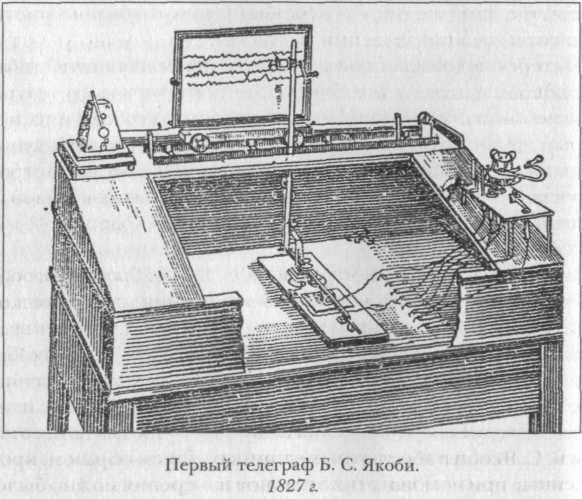
Jacobi in 1845 made a switchboard synchronous device with a horizontal dial, an electromagnetic drive and a keyboard, and by 1850 - the world's first direct-typed telegraph. Only his work was considered by the government to be a military secret, therefore very few people knew about the project.
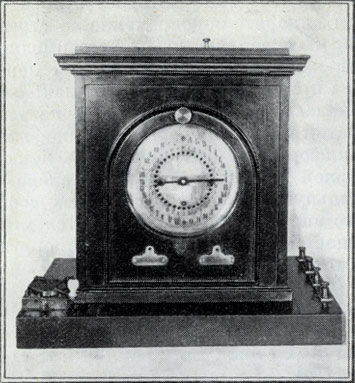
B.S. Jacobi switch telegraph with vertical dial
In 1844, Jacobi was invited to build a telegraph line along the railway between Moscow and St. Petersburg. The inventor proposed to include in the line an auxiliary battery, which will enable transmissions if the insulation of the underground cable is damaged. A similar device is then used when laying the cable along the bottom of the Atlantic Ocean.
Unfortunately, Jacobi did not complete the line, and the German company ”Siemens & Halske” finally received an order for the construction of a network of telegraph lines .

Arrow telegraph unit "Siemens & Halske"
In 1852, the first telegraph station was founded in Moscow in the building of the Petersburg-Moscow Railway Station. On October 1 of this year, the company Central Telegraph begins its history. In 1869, the station moved to Myasnitskaya street.
By the end of 1855, the telegraph covered the cities of Central Russia and began to connect the country with Europe. In 1880, several types of telegraph devices and teletypes were used in Russia.
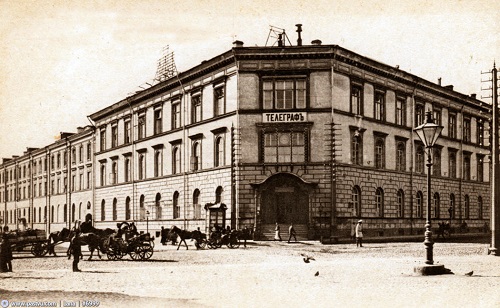
Central Telegraph on Myasnitskaya Street, circa 1900
USA
American inventor Samuel Morse patented his version of the telegraph in 1840. The key or "hammer" closed and opened the electrical circuit, the automatic receiver recorded the signals. The current pulses of a certain duration made the electromagnetic pen oscillating, reproducing the “dots” and “dashes” on the paper tape. The pen either squeezed the signals or applied them with ink.

Telegraph key, it is a "hammer"
In 1843, Congress passed the bill and provided the inventor with a subsidy for the construction of a 65-kilometer-long line between Washington and Baltimore.
The first attempt to lay the cable underground using the invention of Ezra Cornell - a special trench plow - was unsuccessful. But in 1844 the line was opened, the wires went along the telegraph poles. So it was possible to save on isolation.
The former general postmaster in two presidential cabinets, Amos Kendall, immediately realized how useful the telegraph with its highest information transfer rate was and attracted investors to the project. Morse began selling licenses for his invention, and by 1851 fifty independent telegraph companies had opened in the United States.
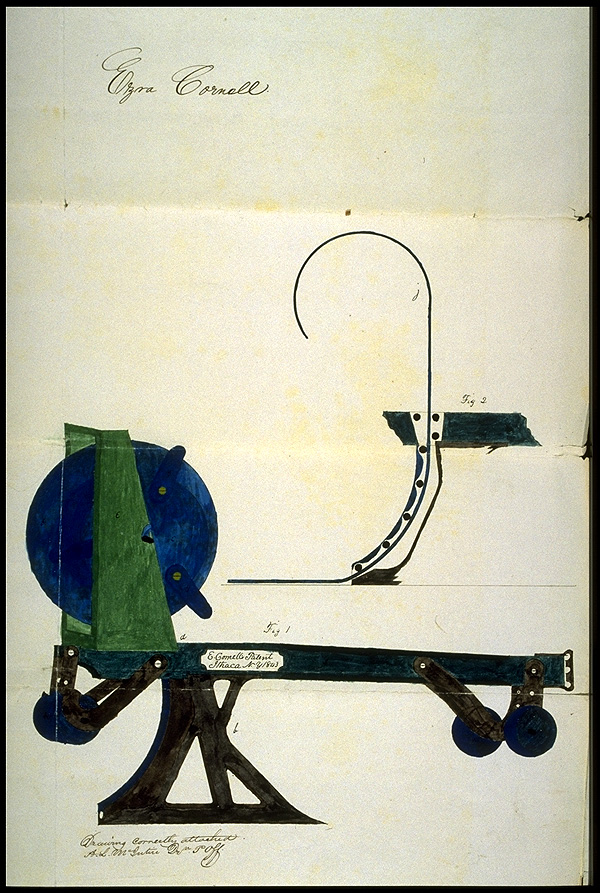
Illustration of Ezra Cornell's patent on a cable plow. A source
In 1846, Royal Earl House patented a printing telegraph capable of transmitting forty words per minute. The patent for this type of telegraph was owned by Judge Samuel Selden, with whom Hyrum Sibley, sheriff of Monroe County, New York, founded the New York and Mississippi Valley Printing Telegraph Company (NYMVPTC). Seven years later, the name changed to “Western Union” - “Western Union” .
Instead of building new telegraph lines, entrepreneurs began to buy existing ones and merge them into one system. For three years, the number of Western Union offices has increased to 4,000, and the capital - from 220 thousand dollars to 48 million.
Send a telegram to the United States in 1854 cost $ 20 per message. Because of this, there were not so many volunteers, and businessmen willingly sold their companies to Hiramu Sibley. In 1854, Western Union bought a patent for Morse telegraph.
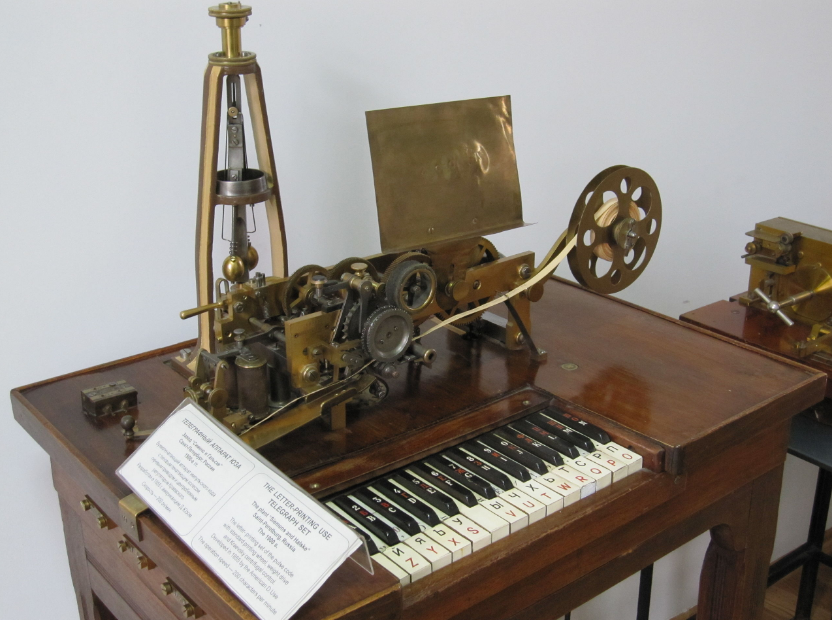
The printing telegraph of 1900, production Siemens & Halske, St. Petersburg
In 1861, the “Western Union” united the Western and Eastern coasts of the United States in a single transcontinental line for 112 days. Before the appearance of this line, the messages went to such a distance for ten days - they were driven by the most courageous and desperate young men on horseback. And not all letters reached because of the constant attacks of bandits.

Laying of the transcontinental telegraph line. A Pony Express employee welcomes builders.
Connection between continents
Submarine telegraph lines in Europe
By the middle of the XIX century, the telegraph networks tied most of the major cities in Europe and the United States - by land. But to send a telegram across the ocean was difficult. Letters continued to go on ships, delivery was carried out for twenty days at best. In a world where international relations were becoming more intense, creating communications between the Old and New World was a matter of time. The idea to lay a telegraph wire on the bottom of the Atlantic Ocean was expressed by Samuel Morse, then it was supported by the English physicist Charles Whitson. But she was rejected as impracticable. Gutta-percha, discovered in India, which Werner von Siemens offered to use for isolation, came to the aid of entrepreneurs and scientists.
One of the first submarine lines began to lay the English engineer John Brett between France and England. The warship "Vigdeon" pointed the way "Goliath" with a cable on board the way, marking it with buoys with flags. The cable was immersed in water, a load of 10 kilograms of lead was hung to it every 15 minutes. The first telegram went along the line, but immediately after it the connection stopped working. A French fisherman accidentally pulled out a piece of cable with a net.
The first cable consisted of two copper wires two millimeters thick, covered with a gutta-percha sheath. For the second attempt, four wires were used, each of which was protected with a gutta-percha sheath with a thickness of six millimeters. All the wires, together with five round tarred and fat-soaked hemp cords, were twisted into one cable, entwined with a common hemp tarred cord. Another hemp layer was laid on top, and already after wrapping the cable with ten galvanized iron wires with a diameter of seven millimeters. The first cable weighed 14 tons, and the second, improved, already 166 tons. Now, the accident in the form of a net thrown into the sea could not prevent communication between countries.
In November 1852, a direct telegraphic communication was established between London and Paris, and later connected England with Ireland, Germany, Holland and Belgium. Sweden joined with Norway, Italy - with Sardinia and Corsica. In 1854-1855 the cable was laid across the Mediterranean and Black Sea.
Transatlantic cable
The entrepreneur Cyrus West Field, using the experience of the companies that laid the submarine cables, has collected investments sufficient for the project of laying the cable along the bottom of the Atlantic Ocean. In 1856, the ships Agamemnon and Niagara departed from the coast of Ireland, each had on board for a coil of a cable weighing one and a half thousand tons. The cable was made of a seven-wire copper cable with a gutta-percha sheath, the cores of which were fitted with tarred hemp, and outside the cable was wound with another 18 cords of 7 iron wires each. The cable length was four thousand kilometers.

Route for the construction of the transatlantic communication line: Ireland - Newfoundland
A few days later the cable broke, and the project had to be postponed. After a few months, the second attempt took place - again a failure. The third attempt took place in 1858, they managed to lay a cable from Ireland to Newfoundland. August 16 of that year, Queen Victoria of Great Britain congratulated US President James Buchanan on a successful project, but a few months later the connection was broken.
Cyrus Field and then did not give up. Eight years later, in 1864, he began laying the cable with improved insulation with the help of the British steamer Great Eastern with a displacement of 32 thousand tons. The cable broke during installation. In 1866, the same ship made a second attempt - and then it finally turned out to provide communication between Europe and America. A previously torn cable was found and sealed with the second fragment, so that it also began to function.
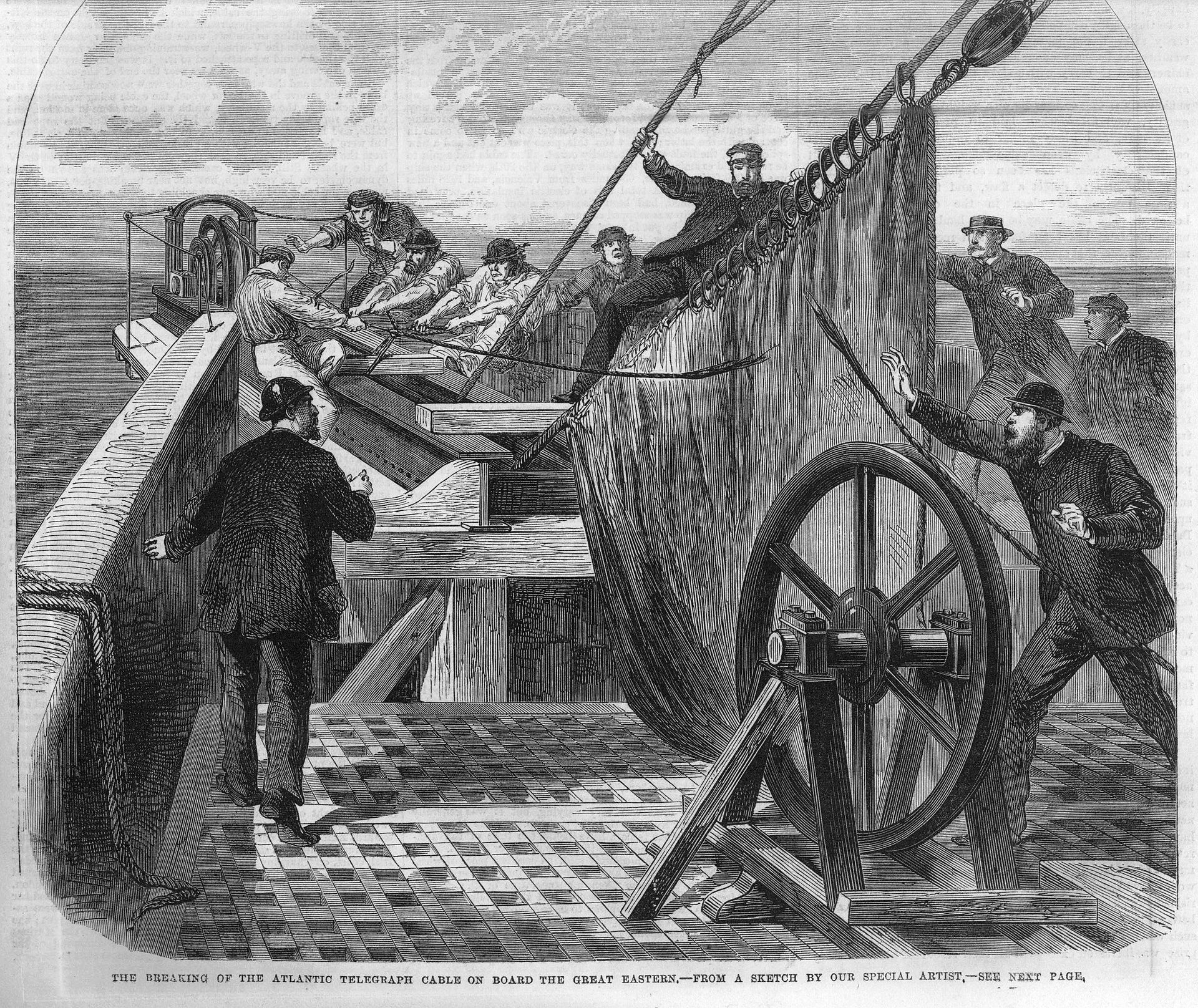
Scene of cable break at Great Easternne. The Illustrated London News. Band 47. 1865. Source
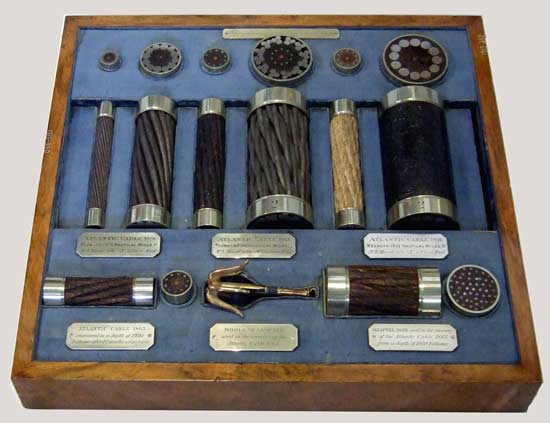
Samples of cables that formed the transatlantic link
From USA to Europe via Alaska
American “Western Union” decided to take a different path - through Alaska. In 1867, Russia sold Alaska to the United States for $ 7.2 million, and Western Union received the authority to lay lines along the military and postal routes, including railway lines.
The project of laying a cable through Alaska called the "Russian-American Telegraph." He proposed a line from San Francisco in California to Moscow through Oregon, Washington territory, Colombia, Alaska, the Bering Strait and Siberia, which made it possible to connect the United States and Europe.
Although the project failed, it gave impetus to the development of all the territories through which it passed.
 Telegraph line in Alaska
Telegraph line in Alaska
The main telegraph lines in 1891
In 1870, a cable was laid to India to establish a connection between London and Bombay through Egypt and Malta. The main telegraph lines in 1891 are visible on the map below.
In addition to greetings and news
Money transfers
The ability to instantly transmit messages over long distances opened the way for new types of business. Money in the mail in Russia according to the Great Soviet Encyclopedia sent from 1781. In the XIX century, a modernized service appeared - postal orders. Not bills were sent by mail, but special coupons that the recipient brought to the post office in order to withdraw cash. And to put bills in envelopes banned.
An extensive telegraph network in the United States allowed Western Union to begin providing telegraph money transfers in 1871. The service turned out to be so popular that after five years the company conducted 37,190 transfers worth $ 2.6 million, with an average transfer amount of $ 70. This is more than 56 million dollars in 2016 prices. This service is now the main business for the company. In 2015, Western Union made 262 million remittances between customers for a total amount of $ 82 billion.
In the Soviet Union, remittances were one of the important public telegraph services .

Telegraphic transfer form, USSR
Stock market quotes
In the middle of the XIX century in the United States began to emerge the stock market. Securities traded on the exchanges themselves. It would be much more convenient to find out the current quotes, sitting in a brokerage office, and make purchases and sales directly from it. This opportunity was opened by the telegraph, bringing the trade in securities to real-time.
Royal Earl House in 1846 patented the printing telegraph, which issued the text at the exit. It was the great-great-great-great-grandfather of modern printers. The first model was fragile, often the synchronization between the sender and the recipient was broken. To print one letter, several current pulses were needed, and the system did not work at long distances. The model improved by David Hughes worked with the help of watch movements - this was how the synchronization of the devices was achieved. This model was used in Russia from 1865 until the beginning of World War II.
, , . 1869 , .
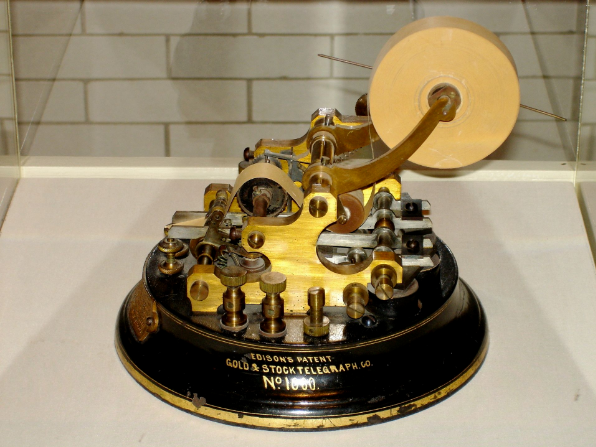
. 1930- , - «Western Union», , . 1877 - - , . , 96 . - . .
. . XX « ».
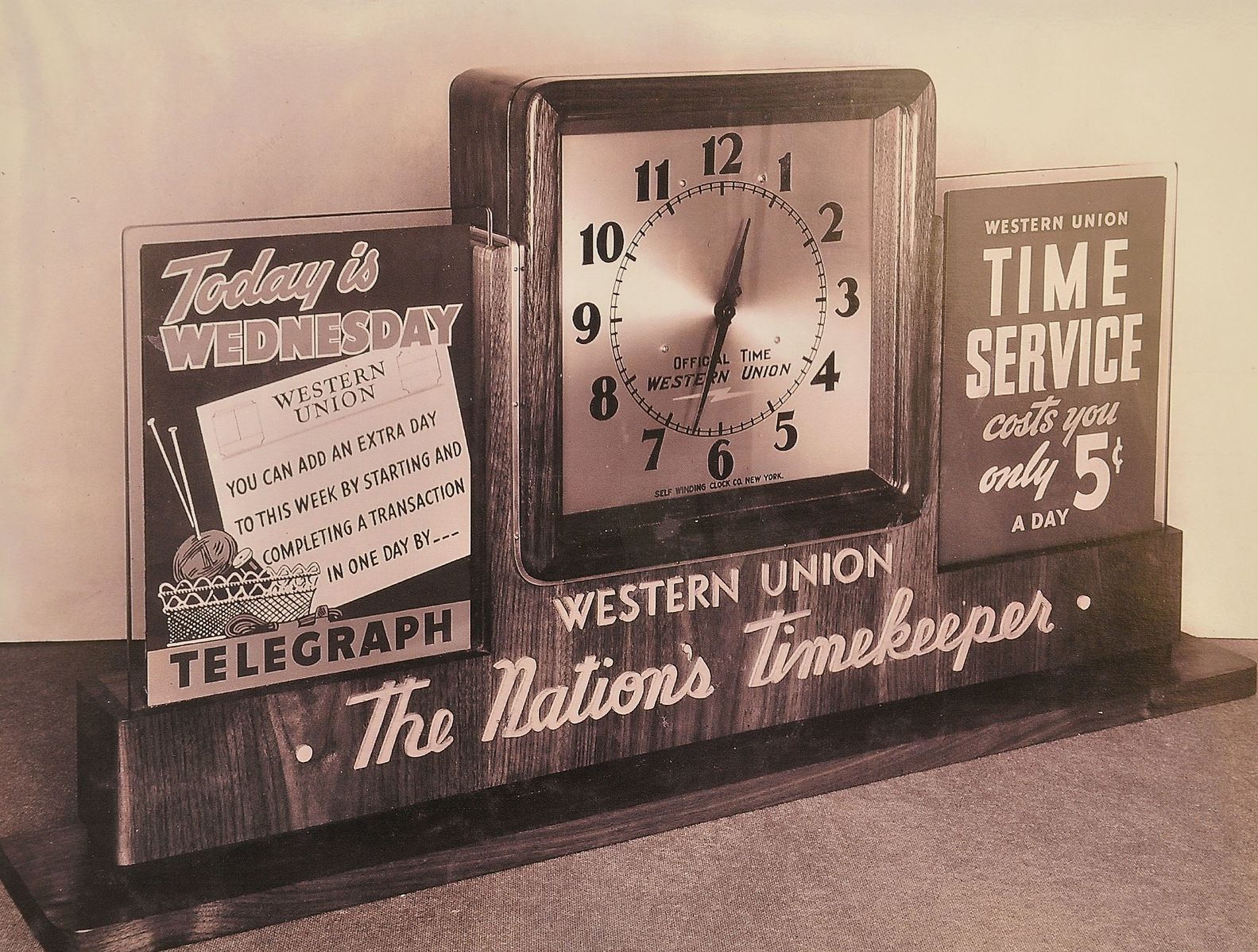
Western Union
. , — , , .
, "" . , .
1872 , . , , — . . , . 1877 — . XX , 760 . , , .
, . , . — , .
1901 , . 5- .

:
. — .
1920- « », 600 100 . . , , .
, , tty ( TeleTYpe) Unix. , .
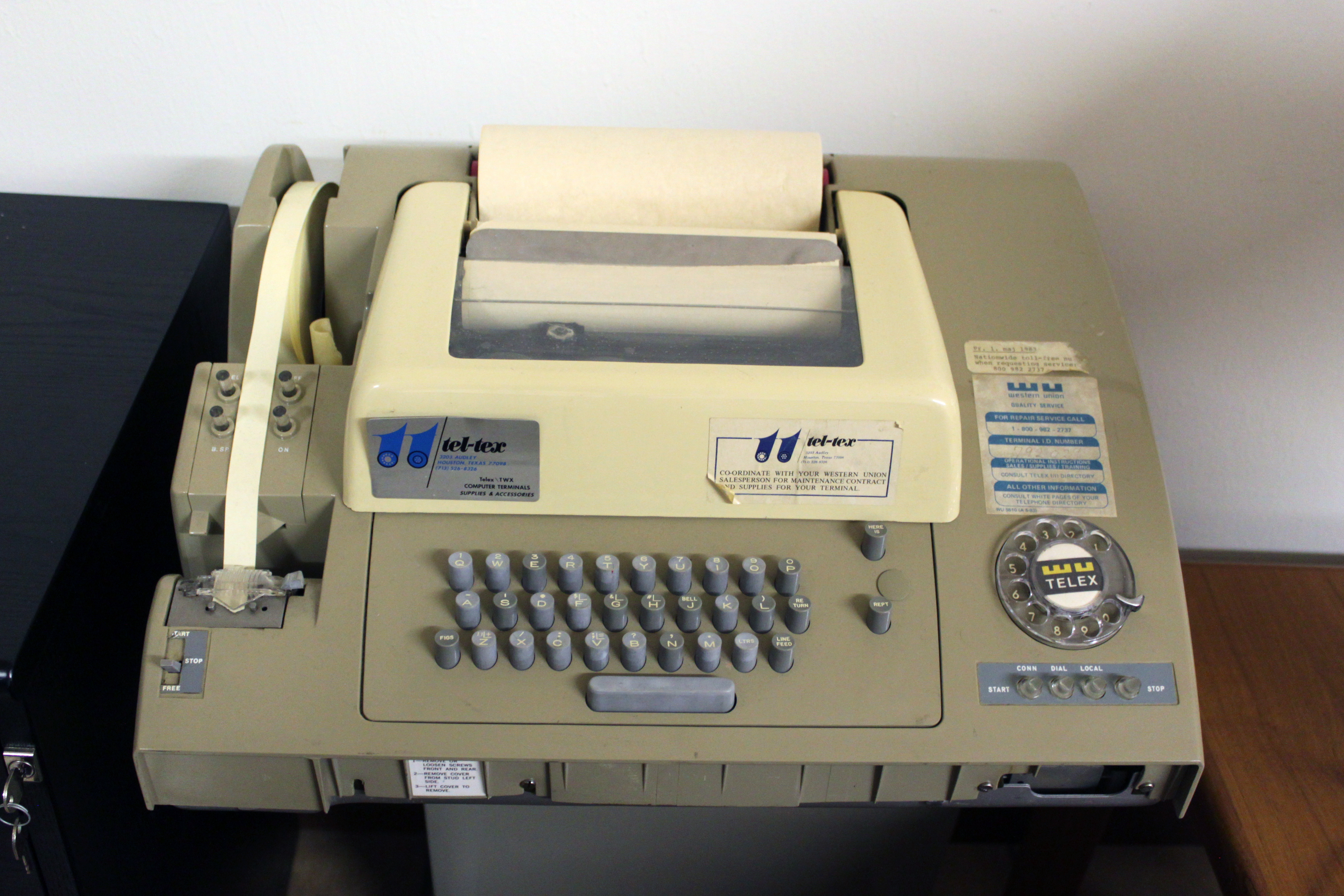
, Telex
«Western Union» 2006 , . 2004 , 2013 — . , , . , , . , , , . , .
')
Source: https://habr.com/ru/post/396283/
All Articles
